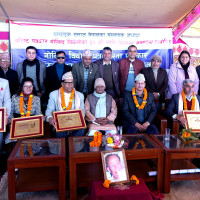- Saturday, 17 January 2026
Large swathe of forest areas encroached in Madhes and Lumbini provinces
By Our Correspondent,Rupendehi, Aug. 9: As deforestation for settlements increases, the Lumbini and Madhes provinces' forest area is shrinking. Among the 12 districts in the province, Rupandehi has seen the highest encroachment.
Our Rupendehi correspondent Kapil Gyawali reported that public structures, houses, schools, club buildings, and social organisation boards have been constructed on the encroached land in Rupendehi.
According to Yagyamurti Khanal, Undersecretary of the Forest Directorate, even those responsible for conserving natural resources have been involved in deforestation.
As per the latest fiscal year 2023/24 statistics from the Provincial Forest Directorate, over 14,600 hectares of forest area out of the province's 974,381 hectares have been encroached by humans.
Senior Forest Officer and Information Officer Sujan Dhimal informed that 8,347 hectares of forest have been encroached in Rupandehi alone.
Rupandehi has a total forest area of 24,976 hectares, of which 8,000 hectares are encroached. In Kapilvastu, 2,388.3 hectares out of 69,448 hectares are encroached, while 746 hectares in Nawalparasi, 607 hectares in Banke, 287 hectares in Bardiya, and 2,134 hectares of forest in Dang have been encroached.
Similarly, 84 hectares in Gulmi, 51 hectares in Rolpa, 18 hectares in Arghakhanchi, 14 hectares in Pyuthan, and 10 hectares in Palpa have been encroached. As of the second week of June this year, the province has reclaimed 123 hectares from encroachment, according to Dhimal.
However, he said that reclaiming forest areas encroached by large settlements would be difficult.
“Roads have passed through the forest, and settlements have been established nearby. Therefore, reclaiming the encroached forest areas is challenging,” he said.
In Lumbini Province, 18 local levels have less than 1,000 hectares of forest area. Nine local levels, including Kotahimai, Marchwari, Mayadevi, Samarimai, and Lumbini Cultural Municipality in Rupandehi have no national forest. Similarly, in Kapilvastu, Suddhodhan Rural Municipality, Yashodhara Rural Municipality, and Krishnanagar Municipality also lack national forests. Janaki Rural Municipality in Banke has no forest area as well.
Dang has the highest forest area in the province, with 193,450 hectares. Other significant forest areas include Banke with 115,776 hectares, Palpa with 64,218 hectares, Arghakhanchi with 73,235 hectares, Bardiya with 31,729 hectares, Gulmi with 46,098 hectares, Kapilvastu with 60,448 hectares, Nawalparasi with 21,859 hectares, Pyuthan with 64,218 hectares, Rolpa with 98,896 hectares, Rukum East with 55,316 hectares, and Rupandehi with 24,976 hectares.
There are only 4,037 community forests in the province, covering 429,426 hectares. Other types of forests include 406 leasehold forests, 932 private forests, 30 religious forests, eight partnership forests, two block forests, and six protected forests.
32.72 million cubic feet of timber production
Lumbini Province produces 32.72 million cubic feet of timber annually from its 12 districts. Another 8,482 stacks of firewood are produced.
According to the Kapilvastu Division Forest Office, the district produces 679,579 cubic feet of timber and 1,696 stacks of firewood. Other significant quantity of timber production comes from Arghakhanchi with 466,954 cubic feet, Nawalparasi with 358,000 cubic feet, Gulmi with 334,000 cubic feet, and Banke with 326,000 cubic feet.
The Gautam Buddha Division Forest Office produces 231,000 cubic feet, Bardiya 218,000 cubic feet, Rupandehi 202,000 cubic feet, Deukhuri Division Forest Office 173,000 cubic feet, Pyuthan 117,000 cubic feet, Dang Division Forest Office 82,556 cubic feet, Palpa 49,767 cubic feet, and Rolpa 30,145 cubic feet of timber annually. There is a pressing need to launch a campaign to protect the forests.
Similarly, our Dhalkebar correspondent Vijay Kumar Sah reported that the Siraha Division Forest Office demolished illegal structures and reclaimed three hectares of encroached forest land in Naraha Rural Municipality-3, Jobaha on Monday. Some individuals had occupied this land for 30 years, running hotels.
Division Chief Sujit Jha of the Siraha Division Forest Office said that they plan to plant trees on the reclaimed land. He added that the office has reclaimed 42 hectares of encroached forest land in the previous and current fiscal years. Siraha has a total forest area of 27,902 hectares, with 943 hectares encroached.
Similarly, Dhanusha Division Forest Office has reclaimed about two hectares of encroached forest land in Sikari Danda, Mithila Municipality-11. They fenced the reclaimed land with wire mesh and planted 35,000 medicinal plants.
Division Chief Bechan Chaudhary of the Dhanusha Division Forest Office said that 35 hectares of encroached forest land were reclaimed in the fiscal year 2023/24. Dhanusha has a total forest area of 27,578 hectares, with 837 hectares encroached.
Due to the increasing forest encroachment, relevant authorities have been proactive in reclaiming forest areas. According to the Ministry of Forest and Environment, Madhesh Province reclaimed 214 hectares of encroached forest land in the fiscal year 2023/24, with the highest being 57 hectares in Bara. However, 16,599 hectares of forest land are still under encroachment in the province.
The Minister of Forest and Environment of Madhes Province, Tribhuvan Sah, said that they are holding discussions with concerned agencies and formulating concrete plans to protect the forests from encroachment.
He expressed concern over the increasing natural disasters due to encroachment and mentioned coordination with administrative bodies and political parties.
Uddhav Bahadur Ghimire, Secretary of the Ministry of Forest and Environment, said that circulars have been issued to all eight district division forest offices under the ministry to manage forest encroachment actively.
Officer Suresh Sharma of the Provincial Forest Directorate said that despite the forest areas being under the provincial jurisdiction, the administration operates under the federal government's direction and coordination, making forest encroachment management challenging.
Due to rapid expansion of human settlements, agriculture, industry, and infrastructure, forest encroachment and the destruction of valuable ecosystems have increased in Madhes Province, Sharma said.
Madhesh Province has the smallest forest area in Nepal. Despite 45 per cent of Nepal's total land area being forested, Madhes Province has only 3.72 per cent forest coverage, amounting to around 202,202 hectares. Out of the 136 local levels in the province, 89 have no forest land.
















